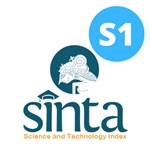Hazardous Area Classification Assessment at a Pharmaceutical Industry in East Jakarta

Downloads
Introduction: Fire is a common risk in any industrial facility that uses combustible and flammable raw materials, products, or supporting materials. Among others, the pharmaceutical industry is exposed to such risk due to the application of flammable liquids including ethanol as a volatile solvent in production areas, which has the potential to form explosive atmospheres through evaporation from pools created by accidental releases. Therefore, this study aims to analyze the hazardous area classification (HAC) in ethanol storage areas to facilitate the execution of risk mitigation efforts for reducing the role of ignition sources that cause fire and explosion. Methods: The HAC assessment was carried out in December 2021 - January 2022 using the quantitative method outlined in the International Electrotechnical Commission (IEC) standard: IEC/EN 60079-10-1 for zone determination. During flash point analysis, the ASTM D-93 method was employed to define the class of ethanol as a flammable liquid. Results: The ethanol storage areas fell into the zone 2 category based on the secondary grade of release, as well as the areas' ventilation effectiveness with a medium dilution, and fair ventilation availability. The extent of zone 2 is up to 3 m from the release source. Conclusion: Ignition sources capable of leading to fire and explosion incidents in ethanol storage areas should be controlled.
Ahirwal, B., Singh, A.K. and Vishwakarma, R.K. (2015) ‘Area Classification and Types of Protection for Explosive Atmospheres: A Review', TELKOMNIKA: Indonesian Journal of Electrical Engineering, 16 (2), pp. 238–243.
Bahadori, A. (2014) Hazardous Area Classification in Petroleum and Chemical Plants: A Guide to Mitigating Risk. 1st edn. Florida: CRC Press.
Bozek, A. (2018) ‘Application of IEC 60079-10-1 Edition 2.0 for Hazardous Area Classification', IEEE Transaction on Industry Application, 54 (2), pp. 1881–1889.
Buyukkidan, B., Gumus, H. and Uslu, Ö.A. (2021) ‘The Risk Calculation of Hazardous Zones Created By Flammable And Explosive Chemicals, LPG Tank Example', Academic Platform Journal of Natural Hazards and Disaster Management, 2 (2), pp. 47–62.
Choi, J.Y. and Byeon, S.H. (2021) ‘Specific Process Conditions for Non-Hazardous Classification of Hydrogen Handling Facilities', Safety and Health at Work, 12 (3), pp. 416–420.
El-Zahlanieh, S. et al. (2020) ‘Hydrocarbon Aerosol Explosion: Towards Hazardous Area Classification', in 13th International Symposium on Hazards, Prevention, and Mitigation of Industrial Explosions (ISHPMIE 2020), pp. 572–583.
Goyette, J. (2011) ‘NFPA 36 ROP TC Letter Ballot (F2012)'. Massachusetts: National Fire Protection Association 1.
Guillaume, E. et al. (2013) ‘Ethanol Fireplaces: Safety Matters', Safety Science, 57, pp. 243–253.
International Electrotechnical Commission (2020) Explosive Atmospheres - Part 10-1: Classification of Areas - Explosive Gas Atmospheres, Geneva: International Electrotechnical Commission.
Jae, Y., Chang, J. and Lee, J. (2018) ‘Study on the Estimation Model of Liquid Evaporation Rate for Classification of Flammable Liquid Explosion Hazardous Area', Journal of the Korean Society of Safety, 33(4), pp. 21–29.
Lauri, R. (2020) ‘Bioethanol Storage Depots : Study of Evaporation from Pool for the Classification of Hazardous Zones due to the Possible Formation of Potentially Explosive Atmospheres', Chemical Engineering Transaction, 79 (December), pp. 169–174.
Lauri, R. (2021) ‘Assessment of Atmospheric Parameters Influence on Dilution Degree : A Case Study Focused on Formation of Explosive Atmospheres in Bioethanol Storage', International Journal of Latest Engineering Research and Applications (IJLERA), 6 (7), pp. 8–15.
Lestari, F. et al. (2021) Keselamatan Kebakaran (Fire Safety). Depok: Fakultas Kesehatan Masyarakat Universitas Indonesia.
Marando, M. (2021) Storing Flammable and Combustible Liquids in Containers using NFPA 30.
Nilsen, S. et al. (2007) ‘Determination of Hazardous Zones for a Generic Hydrogen Station- A Case Study', in Hydrogen Tools, pp. 1–13.
Onyekwelu, K.C. (2019) ‘Ethanol', in S.G. Taukeni (ed.) Psychology of Health- Biopsychosocial Approach. London: Intech Open.
OSHA (2022) Section IV (previously Section III of Oregon OSHA's Technical Manual).
Pal, D. (2019) ‘Hazardous Area Classification in Pharmaceutical Industry', International Journal of Engineering Research & Technology, 8(3), pp. 134–138.
Setiawan, E., Nugroho, A. and Zaman, B. (2020) ‘Analisis Sistem Keselamatan dan Kesehatan Kerja pada Lingkungan Area Berbahaya', Indonesian Journal of Halal, 3 (1), pp. 88–93.
Sjöström, J. et al. (2015) ‘Thermal Exposure from Large Scale Ethanol Fuel Pool Fires', Fire Safety Journal, 78, pp. 229–237.
Tommasini, R., Pons, E. and Palamara, F. (2014) ‘Area Classification for Explosive Atmospheres: Comparison between European and North American Approaches', IEEE Transactions on Industry Applications, 50(5), pp. 3128–3134.

This work is licensed under a Creative Commons Attribution-NonCommercial-ShareAlike 4.0 International License.

In order to be accepted and published by The Indonesian Journal of Occupational Safety and Health, Author(s) who submit an article should complete all the review process. The copyright of received articles assigned to the The Indonesian Journal of Occupational Safety and Health and Department of Safety and Health, Universitas Airlangga as publishers of the journal. The intended copyright includes the rights to publish articles in various forms (including reprints).
The Editorial Team of The Indonesian Journal Of Occupational Safety and Health and Department of Safety and Health strive to ensure that no errors occur in the articles that have been published, both data errors and statements in the article.
Users of this website will be licensed to use materials from this website following the Creative Commons Attribution-NonCommercial-ShareAlike 4.0 International License. No fees charged. Please use the materials accordingly.
------------------------------------------------------------------------------------------------------------------------------------------------------------------------------------------
Attribution ” You must give appropriate credit, provide a link to the license, and indicate if changes were made. You may do so in any reasonable manner, but not in any way that suggests the licensor endorses you or your use.
NonCommercial ” You may not use the material for commercial purposes.
ShareAlike ” If you remix, transform, or build upon the material, you must distribute your contributions under the same license as the original.







 How to Submit Articles in OJS
How to Submit Articles in OJS

























